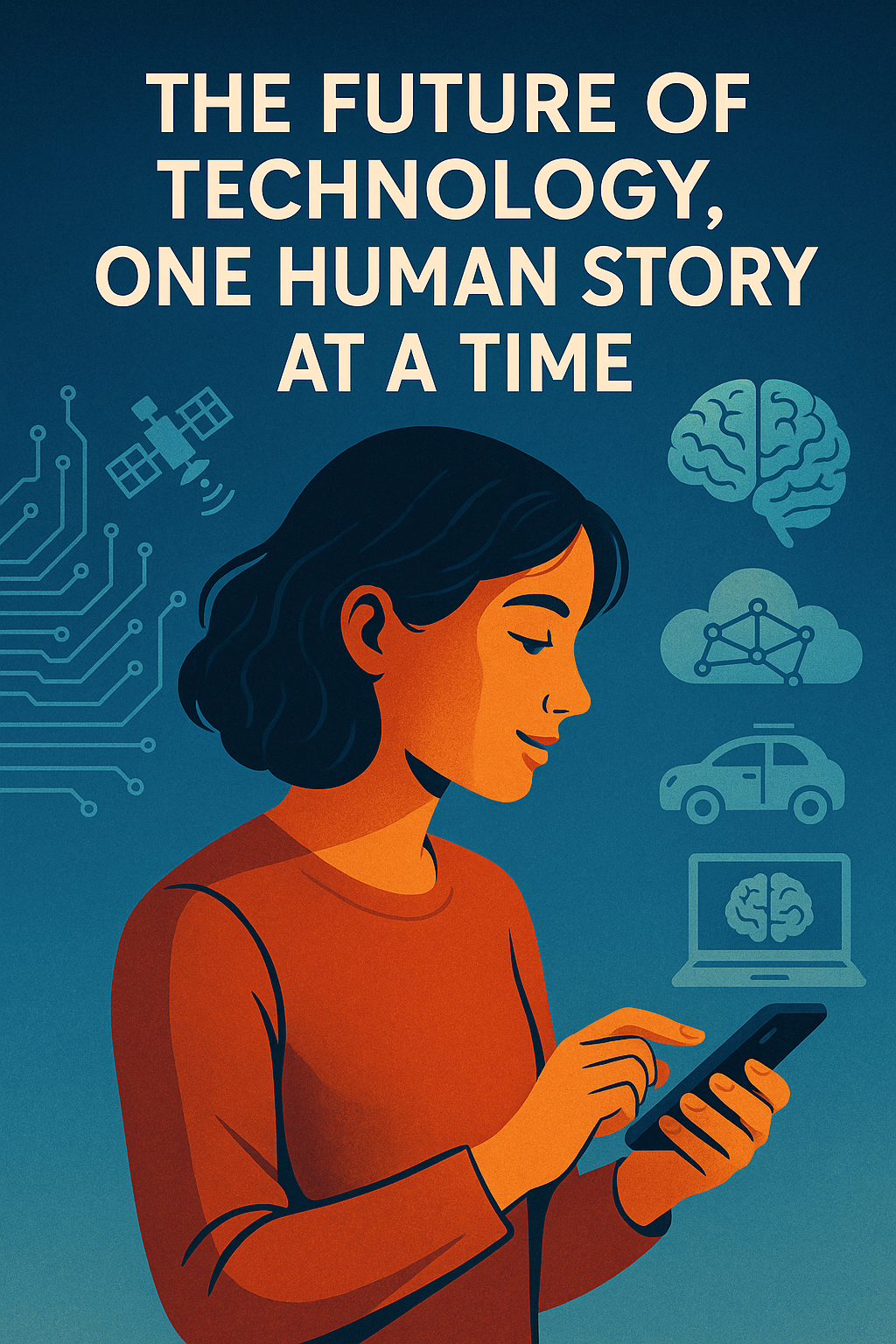Today, technology is advancing at an accelerated rate everywhere we look. While we sleep, virtual worlds are being created, machines are learning to drive, and artificial intelligence is producing articles. However, the human tale is one component that is frequently overlooked in the midst of the innovations and buzzwords.
Because there is a person behind every invention, new software, and technological advancement. A necessity. A wish. A phobia. A dream.
📱 Technology Is Connection, Not Just Code
When was the last time you actually benefited from a piece of technology?
.After a hard day at the office, perhaps your smartwatch was telling you to get up and take a walk. Or a video chat with your granny who lives on the other side of the world. Or an app that assisted you in breathing and meditation when things became rough.
These are not only characteristics. These are impactful moments. Little but impactful illustrations of how technology permeates everyday life.
And that’s the future we envision: one in which technology becomes more human rather than merely smarter.
💬 Actual Impact, Actual People
Amira, a Moroccan single mother, got her first online freelance job by using a free YouTube coding school. She was able to purchase a laptop thanks to that one employment, and she is currently teaching coding to people in her neighborhood.
Ravi, an 18-year-old from rural India, started a successful tech YouTube channel from his phone by using a cheap AI program to produce voiceovers in English.
Lucas, a Brazilian wheelchair user, used open-source tools to modify smart home technology so he could be completely independent at home using just his voice.
These aren’t startup CEOs or tech millionaires. They are merely human. People who used technology to regain control over their own lives rather than to rule the world.
Why the Future Is in Human-Centered Technology
The next decade of innovation won’t be won by the fastest processors or the flashiest apps. It’ll be won by the platforms that serve humans, understand their needs, and build trust.
AI that listens — not just responds.
Websites that are accessible to everyone, regardless of ability.
Social networks that prioritize well-being over engagement time.
WordPress sites that amplify unheard voices and underserved communities.
And yes, it starts with creators, developers, and writers — like you and me — who choose to tell human stories in a digital world.
.
Concluding Remark
“Where is technology going?” is a common question. Perhaps a more pertinent query would be:
With whom is it traveling?
Let’s create a future in which technology advances alongside, not ahead of, us. One human tale at a time, let’s write that future.
.
🧠 The Silent Revolution: Ordinary Pioneers
Not every breakthrough takes place in the boardrooms of Silicon Valley. The most significant changes can occasionally take place in the shadows, in schools, kitchens, and tiny cafes with just one lightbulb and a common goal.
Because her students cannot afford textbooks but can buy data bundles, a Kenyan teacher uses a $40 phone and WhatsApp to livestream her sessions.
In Canada, a retiree teaches other seniors how to use telehealth apps because it makes the difference between loneliness and dignity, not because it’s a requirement.
In Ukraine, a teenager uses open-source software and spare components to reconstruct damaged computer laboratories for local children.
One act of empowerment at a time, rather than multibillion-dollar initial public offerings, is the true digital transformation.
🌱 Technology That Does More Than Just Work
With calendars full of Zoom calls, reminders that buzz constantly, and social media feeds that never stop updating, we frequently equate technology with speed, hustle, and productivity.
But what if slowing down is also the way of the future for technology?
Apps designed to improve your sleep, not increase sales.
platforms where click-through rates are subordinated to mental wellness.
communities that foster relationships rather than comparisons.
If technology is intentionally created, it can be a positive influence on wellbeing. And if we tell the important stories.
🛠️ Human Construction Begins with Listening
It is our duty as engineers, authors, or tech aficionados to design carefully, listen intently, and put people before procedures.
When creating a WordPress website, inquire:
Are all users able to access it?
Does it use inclusive language?
Does it only highlight features or does it actually address a problem?
In addition to being morally right, human-first design is the way of the future. Users want less noise and more meaning. And the platforms and companies who pay attention to that change will be the ones that survive.
.
A Future That We Can Trust
The hoopla around AI, smart devices, blockchain, and deepfakes can easily overwhelm one. But beneath it all is a reality that is all too frequently overlooked:
Our future is defined by us, not by technology.
The instruments will change. The patterns will shift. However, our goal is still the same:
to establish a connection.
to comprehend.
to narrate tales.
to be a person.
Therefore, the next time you publish a blog post, browse a feed, or create a new website, ask yourself:
Whose tale am I narrating?
Who can I even somewhat assist?
What sort of future am I creating for myself and other people?
❤️ Concluding Remarks: Tell the Story That Motivates Change
To influence the future, you don’t have to be a tech CEO, engineer, or programmer.
All you have to do is care.
to take note.
to construct anything from the heart.
Because better people behind the screen will drive technology in the future, not simply smarter machines.
So let’s continue to share those tales.
A single blog entry.
Just one project.
Human narrative by human story



